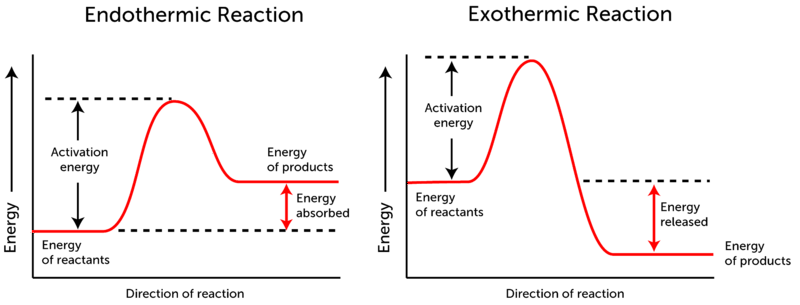
Why is there an absorption of energy in certain chemical reactions that release of energy in other reactions?
Answer
478.5k+ views
Hint: Basically, there are two types of reaction. The first is an endothermic reaction while the second is an exothermic reaction. The primary difference between these two reactions is that one absorbs the heat from the surrounding while the other releases the heat.
Complete answer:
- The endothermic reactions are the chemical reactions in which the reactants absorb heat energy from the surroundings to form products whereas in case of exothermic reaction, the heat is released. Basically, if a reactant molecule in a particular reaction has more energy than the product molecules then the energy is released and this type of reaction is known as exothermic reaction.
- However, if the product molecules have more energy than the reactants, then the reaction absorbs energy from the surroundings and this type of reaction is known as endothermic reaction.
- Now, the activation energy refers to the energy that must be provided to the reactants so that they can overcome the energy barrier and react. The energy level diagrams for both the reactions are as shown:

In case of exothermic reactions, the potential energy of the product is generally lower than that of the reactant but on the other hand, in case of endothermic reaction, the potential energy of the product is higher than that of reactants.
Note: Some of the endothermic reactions are melting of ice to form water, baking of bread, sublimation of solid
Complete answer:
- The endothermic reactions are the chemical reactions in which the reactants absorb heat energy from the surroundings to form products whereas in case of exothermic reaction, the heat is released. Basically, if a reactant molecule in a particular reaction has more energy than the product molecules then the energy is released and this type of reaction is known as exothermic reaction.
- However, if the product molecules have more energy than the reactants, then the reaction absorbs energy from the surroundings and this type of reaction is known as endothermic reaction.
- Now, the activation energy refers to the energy that must be provided to the reactants so that they can overcome the energy barrier and react. The energy level diagrams for both the reactions are as shown:

In case of exothermic reactions, the potential energy of the product is generally lower than that of the reactant but on the other hand, in case of endothermic reaction, the potential energy of the product is higher than that of reactants.
Note: Some of the endothermic reactions are melting of ice to form water, baking of bread, sublimation of solid
Recently Updated Pages
Master Class 9 General Knowledge: Engaging Questions & Answers for Success

Master Class 9 English: Engaging Questions & Answers for Success

Master Class 9 Science: Engaging Questions & Answers for Success

Master Class 9 Social Science: Engaging Questions & Answers for Success

Master Class 9 Maths: Engaging Questions & Answers for Success

Class 9 Question and Answer - Your Ultimate Solutions Guide

Trending doubts
State and prove Bernoullis theorem class 11 physics CBSE

Who built the Grand Trunk Road AChandragupta Maurya class 11 social science CBSE

1 ton equals to A 100 kg B 1000 kg C 10 kg D 10000 class 11 physics CBSE

State the laws of reflection of light

One Metric ton is equal to kg A 10000 B 1000 C 100 class 11 physics CBSE

Difference Between Prokaryotic Cells and Eukaryotic Cells




